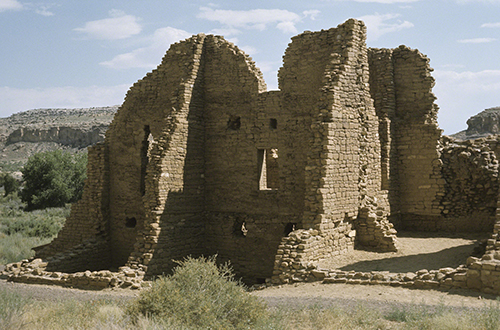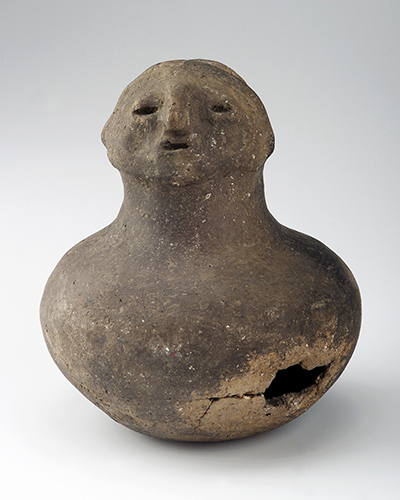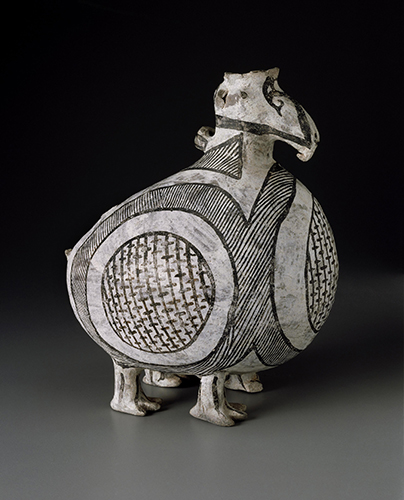Indigenous Peoples Heritage Month: Anasazi, Mississippian, Mogollon
The actual title is “National Native American Heritage Month.” There are so many outstanding examples of the artistic contributions First Nations cultures have made to the history of this country, despite the repression and attempted assimilation of these cultures during the “reservation period.” The repercussions of that period, unfortunately, extend into the present day. For the rest of this month, I’d like to show you art from a number of cultures that I have always found fascinating and enlightening. Long before Jamestown, Plymouth, and the Spanish explorers, indigenous cultures in North America thrived and produced tons of sophisticated art and architecture.
 |
| Anasazi Culture, Ruins of Pueblo Bonito, Chaco Canyon, New Mexico, 900–1000 CE, abandoned around 1150. © Davis Art Images. (8S-11494) |
Evidence of the Anasazi culture exists in the region of the Four Corners (where the borders of Utah, Colorado, Arizona, and New Mexico meet) as early as 1500 BCE. The Anasazi are believed to have developed from hunter-gatherers into farmers around 100 BCE. Various types of domesticated plants from Mexico, such as corn, squash, and beans, had been introduced around 200 BCE.
The Anasazi were dry farmers and relied on the unpredictable rainfall for growth of crops. In approximately 500 CE, the Anasazi became sedentary town dwellers with advancements in more reliable farming techniques. Archaeological evidence from sites in Chaco Canyon indicates that Anasazi groups foraged the open grasslands during most of the year and returned to sheltered canyon dwellings during the winters.
The Anasazi were a very organized culture. They established roads and created platforms from which signals could be sent to neighboring communities. They also had an extensive trade network that extended to Mexico and the eastern Plains—Anasazi pottery fragments have been found as far east as Ohio. By far their most significant achievement was their use of stone and adobe construction to build large communal, aboveground dwellings, predecessors of the pueblo.
Some of the most magnificent examples of Anasazi architecture are in Chaco Canyon, New Mexico. Within a 9.32-mile (15 kilometer) range, there are nearly 300 separate apartment buildings, some on the valley floor and some on top of the mesa. Pueblo Bonito, the grandest of all of these, was built in a semi-circular form.
Pueblo Bonito achieved its final form around 1100. It may have had as many as 800 rooms. Some of the buildings were as tall as five stories. The masonry was finely cut sandstone. Floors were composed of pine beams bound with mud and plaster. The wide walls at the lowest level were able to support multiple stories. The multiple-story buildings are visible in the background of this image.
The metropolis at Chaco Canyon served as a regional hub and ceremonial center for a wide-reaching economy. Shells from California and copper bells and live tropical birds from Mexico all passed through Pueblo Bonito. Many roads, up to 30-feet (9 meters) wide, radiate out of Chaco Canyon, some in a straight line for as far as 30 miles (almost 50 kilometers). Pueblo Bonito, with its close-knit living quarters in communities of small rooms punctuated by large spaces, shows a communal organization that is still important to the Pueblo people to this day.
 |
| Mississippian Culture, Effigy Vessel, from Diehlstadt, Missouri, 900–1400 CE. Earthenware, height: 5 3/8" (13.7 cm). © 2019 Museum of Fine Arts, Boston. (MFAB-472) |
The Mississippian cultures of Tennessee, which flourished from 900 through 1700 CE, descended from the so-called “mound-builder” cultures of the late prehistoric period. The Mound Builders constructed mound lodgings and burial chambers of pounded earth with thatch roofs.
The Mississippian cultures included the Chickasaw, Cherokee, Chicamauga, Chisea, and Shawnee bands. The earliest report of European contact with these cultures indicates that they built their towns on the mound foundations left by their ancestors.
The Mississippian cultures were primarily farmers who raised vegetables, tobacco, and corn. After the middle of the 1700s, they acquired horses, cattle, and pigs from the English settlers and began raising a considerable number of livestock.
The Mississippian cultures had an extensive trade network by land and via the Tennessee and Mississippi Rivers that extended from the Great Lakes to the Gulf of Mexico, and from the Mississippi River to the Atlantic Ocean. Although no actual Mexican artifacts have been found at Mississippian sites, artistic evidence exists of contact with the Mesoamerican Mexican cultures, particularly in effigy vessels of this type.
Mississippian ceramic artists—who are thought to have been women—used local clay that was tempered by the addition of ground shell. This kept the clay from cracking during drying and firing. Mississippian artists used the slab and coil methods to build their vessels. This type of buff-colored pottery is typical of Mississippian wares. The white flecks in this pot may be part of the shell tempering agent. Earlier Woodland cultures used sand as temper.
Vessels such as this lend credence to the idea of influence from Mesoamerican (primarily Mexican) ceramics. Human effigy pots are distinctive to the Mississippian cultures among all the other North American indigenous cultures. Mississippian effigy vessels seem to have been limited to the region between present-day Arkansas and southeast Missouri.
 |
| Mogollon Culture (flourished ca. 200–1400 CE), Avian effigy vessel, from western New Mexico, ca. 1000-1175. Earthenware, slip-painted, Cibola White ware, Gallup Black-on-White style, 10" x 7 ½" x 6 ¼" (25.4 x 19.1 x 15.9 cm). © 2019 Museum of Fine Arts, Boston. (MFAB-511) |
The principle ancient cultures of the Southwest were the Hohokam of southern Arizona, the Mogollon/Mimbres of southwestern New Mexico, and the Anasazi of the Four Corners region. All were farming cultures that grew corn, beans, and squash. They were also urban dwellers living in communities of several hundred to several thousand. Their trade network was vast, from central Mexico in the south, California in the west, and the Great Plains in the north and east.
The Mogollon culture developed in the Mogollon Mountains around 200 BCE in small villages made of pit houses. By 300 CE, they had expanded into Anasazi and Hohokam regions. Already at that time, the Mogollon had had extensive contact with Mexican cultures. Mexican traits that emerged in their arts include pottery forms, ball courts, and platform mounds. At its greatest extent, the Mogollon culture extended from eastern Arizona, southwestern New Mexico, western Texas, and northern Mexico.
This vessel, obviously influenced by Mexican animal effigy vessels, is characteristic of the so-called Tularosa style, which flourished between 1000 and 1250. The Tularosa style is typified by a globular body and a crisp black-on-white slip painted decoration. The decoration often consisted of spirals or repeated geometric patterns. Mogollon artists intended for the vessel to be turned in the hands to appreciate the entirety of the decoration. It is believed by archeologists that many of the painted patterns on Tularosa ware were influenced by Anasazi pottery.
To be continued…
Correlations to Davis programs: A Global Pursuit 2E: 2.5; Discovering Art History 4E: 4.10; Discovering Art History Digital: 4.10; The Visual Experience 3E: 14.5


Comments